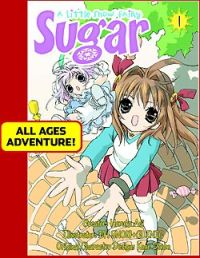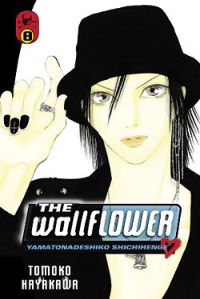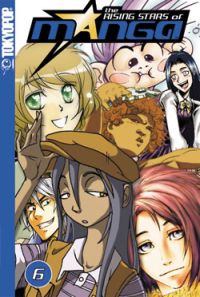RIGHT TURN ONLY!!
The Law of RTO!!
by Carlo Santos,

I'm so glad Anime Expo is over! If I ever see the Yatta guys again it will be too soon.
Listening to Bach's Goldberg Variations on the way home helped to reset my brain from the sensory overload. What's your "opposite of Japanese pop culture" when you need to get away from the fandom?
THE DRIFTING CLASSROOM
 Vol. 1
Vol. 1
(by Kazuo Umezu, Viz Media, $9.99)
FROM THE BACK COVER:
"In the aftermath of a strange earthquake, an entire elementary school vanishes, leaving nothing but a hole in the ground. While parents mourn and authorities investigate, the students and teachers find themselves somewhere far away...somewhere cold and dark...a lifeless, nightmarish wasteland in which their school stands like a lone fortress. As panic turns to terror, as the rules start to fall apart, a sixth-grade boy named Sho and his friends must fight to survive in an alien world..."
PROS:
There are many stories that claim to be "horror," but only a few that seriously get it right. Umezu's classic is one of them, using fear and panic as a propulsive force throughout this volume. The truly terrifying thing about Drifting Classroom isn't the dire situation, but how the victims react to it. Students and teachers alike turn against each other, committing acts of violence that remind us of the thin line between civilization and chaos. When someone draws blood in this story, it doesn't just hurt at the physical level; it's psychological, too. Shadowy, heavily-inked artwork adds to the oppressive mood, especially with Umezu's depiction of the alien wasteland. But even with that intense detail, the straightforward layouts move the story along quickly, delivering shock after emotional shock.
CONS:
The opening chapter, about an argument between Sho and his mother before school, is something of a gimmick to make us feel even more sorry for the lead character. Introducing the protagonist by showing his home and school life is fine, but Sho's inner monologue goes too far with the sentimentality, while the disagreement with his mom goes too far with the theatrics. Only after the school is transported does the story settle into the right mood. The artwork, detailed as it is, also has its moments of crudeness—apparently, any form of running involves swinging your legs out and letting "whoosh lines" appear behind you. Facial expressions lack variety, and the dated character designs might take some getting used to.
RTO!! RATING: A-
THE LAW OF UEKI
 Vol. 1
Vol. 1
(by Tsubasa Fukuchi, Viz Media, $9.99)
FROM THE BACK COVER:
"In a world of powerful celestial beings, an epic contest is being held to select the next king! Each Celestial selects a kid in junior high to be his champion and grants him a special power. The kids battle it out—losers are eliminated, and winners are granted new talents!
Seemingly ordinary Kosuke Ueki has been chosen to be a contender. Granted the power to change trash into trees, Ueki has two disadvantages to overcome—one, he doesn't know he's a participant in the tournament, and two, how the heck can anyone win a battle with the power to turn trash into trees?"
PROS:
You can tell that tournament-style shounen manga has gone postmodern when creators start making up ridiculous powers just for the hell of it. The Law of Ueki's absurdity works in its favor, however, as Volume 1 jumps into action and rides the energy all the way through. Ueki's detached apathy is an amusing reversal of the typical energetic shounen hero, and doubly so when he yawns his way through wild, over-the-top battles. Sure, turning trash into trees and drinking water into fire sound silly enough to merit some eye-rolling, but the ideas are imaginative, if nothing else. And as Ueki gets the hang of his unconventional power, he pulls off some clever fighting moves that you won't see anywhere else.
CONS:
Absurdity for absurdity's sake has been the downfall of many a comedy title (just look at the utterly lightweight Bobobo-bobo-bobobo), and this one is no exception. Ueki just shows up for each fight, with no reason or motivation. The rules of the celestial tournament, which are explained along the way, feel tacked on instead of logically planned out, like a playground game where the kids make up new rules to suit each situation. Silliness and non sequitur are good for a laugh, but as the foundation for the opening chapters of a tournament series (even a satirical one), it's not enough to keep things together. The amateurish artwork drags this one down even further; the artist's limitations are made obvious in his juvenile character designs and tendency to draw in every square inch of available space. It's too much for the eyes, and not enough for the brain.
RTO!! RATING: C-
A LITTLE SNOW FAIRY SUGAR

Vol. 1
(by Haruka Aoi and BH SNOW+CLINIC, ADV Manga, $9.99)
FROM THE BACK COVER:
"Saga Bergman suddenly has her orderly little world twisted into knots when she meets Sugar, a 'Season Fairy' that only she can see! What's more, it turns out that Sugar is still an apprentice, and the only way to become a full-blown fairy is to find 'Twinkles' ... but no one knows where Twinkles are, or even what they are! Can Saga help Sugar and her pals Salt and Pepper find their Twinkles before they drive her crazy?"
PROS:
Any story with a piano-playing lead character wins a special place in my heart, but music is just one of the sweet little flourishes in this series. Numerous other quirks help to establish the world of Sugar: the quaint German small-town setting, the fairies being named after spices and seasonings, the mad-scientist boy next door, and the obsession with waffles. As a character, Saga is a welcome relief from the typical young klutz; instead, she lives exactly by the clock, and the arrival of carefree Sugar causes a friction between the two that effectively drives the story. Saga's connection to her deceased mother through music also adds a layer of bittersweetness. The artwork isn't as cloying as Koge-Donbo's original character designs, but still maintains the energy and sheer cuteness required. Unlike other anime-to-manga conversions that get warped into an awkward style, this one makes the transition painlessly.
CONS:
Saga and Sugar's clashes of personality make for fun entertainment, but the subsequent making-up is enough to make even the most cute-tolerant reader gag. This is a story so hellbent on positive feelings and avoiding conflict that it becomes more of a self-affirmation manual than a tale of personal growth. Each chapter after the first relies on the same pattern: fairy and human have a disagreement, both of them go off to sulk, then someone says something enlightening and everyone is happy again. Clearly, plot and theme are not the main priorities. Page layouts are easy to follow but sometimes get too crowded, especially in Chapter 1, where Sugar's origin story is rushed just so that everything else can get started.
RTO!! RATING: B-
LOVE ROMA  Vol. 3
Vol. 3
(by Minoru Toyoda, Del Rey, $10.95)
FROM THE BACK COVER:
"Time passes so quickly... especially when you're in love for the first time! Hoshino fell for Negishi the very first moment he saw her. But that was in their first year of high school, and now they're about to start their second. Will growing up change their love? Because, all of a sudden, it's time to start planning for the future. They're in the same school now, but someday they'll graduate. Negishi finally meets Hoshino's family, but someday they'll have to start their own. And when they take their first trip together, it seems like it's over almost as soon as it's begun. Can young love stand the test of time... or is time the only thing that can take it away?"
PROS:
It takes nothing less than the guileless innocence of Love Roma to turn something as crass as touching a girl's breast into a moment of poignancy. Odd little scenes like that, among many others, add up to a low-key romantic comedy that miraculously avoids the histrionics of the genre. Volume 3 continues the saga of a clueless but likable boy courting a temperamental but likable girl—and you can't help but root for them all the way. While some series are about trying to get the right couple together, this one shows that even if you do have the right couple, keeping them together is still tricky. Hoshino's unflappable honesty sets up lots of subtle humor, and the arrival of his eccentric family adds new comedic possibilities. The flat, bold-lined artwork—just a bit awkward, like Hoshino and Negi's relationship—adds to the unique flavor, with occasional full-page spreads that deliver the same emotional weight as any swishy, hyper-toned shoujo epic.
CONS:
Of course, if you want a swishy shoujo epic, this isn't going to do it. Toyoda openly admits that he draws each chapter like it were the last, so the series is episodic by nature. Depth is the one thing that's seriously lacking here; we don't learn much about the main characters other than that they like each other, and if Hoshino and Negishi spit out yet another sentimental platitude, it might be time to sign them up for the greeting card industry. With only the passing school year to mark the time, the story also veers into some of usual clichés like flower-viewing in the spring, summer vacation, and a fireworks festival. You'd think a series with such a unique outlook on high school love could also find more imaginative situations to put the characters in. It's very good at being cute, but not so good at being fulfilling.
RTO!! RATING: B
THE WALLFLOWER

Vol. 8
(by Tomoko Hayakawa, Del Rey, $10.95)
FROM THE BACK COVER:
"Four of Japan's most gorgeous guys have the near-impossible task of turning goth-loner Sunako into a lady. When they find Sunako all dressed up and ready for a night on the town, the guys think their luck may have finally changed. Hoping to catch a glimpse of Sunako's date, the quartet follow her out the door. But instead of a handsome young prince, they find an old granny with a taste for the macabre!
Granny's Museum of Horrors is closing shop and she's promised all of the remaining items to her best (and only) customer, Sunako. Just what the guys need—more gruesome artifacts cluttering their house. Sunako plans to bring her horrific treasures home, but the guys will do anything to stop her . . . even if it means all-out war."
PROS:
Although it starts out with a dull meditation on bishounen Takenaga's love life, this volume improves with each succeeding chapter, ending with a Golden Week episode that uses the series' elements to maximum advantage. Sunako's macabre mind imagines a metaphorical desert where the boys' bright-and-exciting holiday plans threaten to scorch her dry; it gets funnier yet when Golden Week actually begins and they learn the dangers of overindulgence. The other chapters also succeed when they exaggerate for comic effect, like a madcap fishing battle, or an ultra-depressed crowd of mourners at a graveyard on flower-viewing day. Hayakawa's simple and sparse layouts make this a breezy read, and yet she also takes time to render those lovely bishounen with their sparkling eyes and fine hair.
CONS:
Now here's a manga that is remarkably adept at getting nowhere. No matter what happens, the events of any given chapter always circle back to the original premise: the boys are still trying to turn Sunako into a proper lady. Also, the less effective jokes in this volume rely on the same old formula that's been regurgitated throughout the series. "Gosh! Those guys sure are hot and popular! Gosh! That girl sure is dark and scary!" The chapter on Takenaga and his maybe-not-quite girlfriend is particularly boring, being devoid of any conflict with Sunako. Nonexistent backgrounds often make it look like the characters are just floating around in space, and sharp-eyed readers will notice some awkward poses and a lack of artistic confidence.
RTO!! RATING: C+

THE RISING STARS OF MANGA

Vol. 6
(edited by Rob Valois, Tokyopop, $9.99)
FROM THE BACK COVER:
"Tokyopop's Rising Stars of Manga competition has launched the revolution—the Manga Revolution! Inside the pages of this book is the next wave of manga visionaries—the artists and writers who have taken visual storytelling to the next level... So treat yourself to a snapshot of the most exciting young voices in manga! In Rising Stars of Manga Volume 6, Tokyopop has once again awarded aspiring artists and writers a unique opportunity to launch their creative careers. These are the manga icons of tomorrow, whose time is now!"
PROS:
The latest iteration of Tokyopop's talent contest shows a remarkable level of variety, spanning genres and target audiences that may not even exist in "proper" manga. The winning story, "Bomango," is a character study propelled by its instantly charismatic lead; coming in second place is the more traditional romance "Boy/Girl" that reaches surprising emotional depths in just 20 pages. Even stories borne out of well-worn ideas, like the fairytale fantasy "The Little Miss Witch Hater," manage to twist those ideas into an explosion of creativity—witness the parasitic magic hat, the unhuggable teddy bear, and the crying violin. Artistic influences are similarly diverse, borrowing styles that range from mainstream children's animation to fantasy illustration to the more accessible side of independent comics. Heck, there might even be a dose of manga in there. But this isn't about imitating Japan: it's about seeing what they do and doing it better.
CONS:
Diversity makes for interesting reading, but it's also every short story anthology's worst enemy, and this one has a couple of "How did that get in?" cases. The worst offender is probably "The Orphans," a nightmare of muddy toning that is near impossible to read. Even high-quality entries have their missteps—"Departure" leads the way in craftsmanship, but there isn't much of a story to back up the stunning art. In fact, the same might be said of all the entries, which struggle valiantly to fit within the contest's page limit. The less accomplished runner-ups always have that feeling of cutting off too soon; a winner emerges by successfully hiding the problem or adjusting the pace accordingly (and so it is that "Bomango" takes top prize). The volume could also do without all those ads and promos for past winners—that's 30 pages of filler right there.
discuss this in the forum (14 posts) |